Another August rolled around and like a bad habit I
was ready to get on the road, take in a show and do some huntin'!
After another great Yuhas show and the best show food in Montana we
were off for another week of vacation hunting on the Cochrane line, or so I
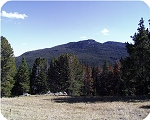
thought.
Finding the line after all these years is more difficult than you would
think unless you know where to look. The first day was spent trying to find the line. Little did I know that I crossed it twice on foot and four times driving. Fortunately my ace in the
hole was just a phone call away... that is when I was in range of cell
service. Without Ron's help finding the line would be nearly
impossible and I already wasted a day of valuable vacation time!
It's dusk when we arrive back at the meadow where Ron said we should be able
to find the line. We setup camp and there is just enough light
for me to do a quick search to see where the line is from our camping
spot. I locate the first pole stump where Ron said it would
be. Looking both directions down the line I'm amazed at how easy
it would be to overlook if you didn't know where it was. Nature
has done a good job hiding the evidence.
Day 1
We are up bright and early the next day and head off to the northwest toward
Porphry Dike. Following the line is somewhat difficult as the
section follows along a meadow where hunters frequent . The
pole sites where devoid of anything very interesting other than some
small

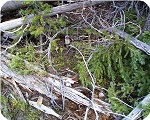
shards
of glass and a couple pole date nails. I brought my metal detector this year in hopes of
finding any hardware that may have gotten hidden by time. It
works great too! I think I dug up every piece of line wire.
Bah! We continue on and eventually enter into a forested
section. The line is easy to follow now, but still no sign of any
line materials. Everything seems to have been cleaned up along
this section. We are about to emerge into a logged area when
there lying along side the trail was a pole complete with crossarms and
hardware. This crossarm has the under arm brackets used when the
line was making a turn. I only found three of these on the
whole line. I would guess that there were originally aprox 6-8 of
these brackets judging by the number of angles in the line.
Searching around the polesite I discover the bottom end to a
Cochrane set. The wood is burnt and it is tied to the guy
wire. I still haven't figured that one out. This pole
originally had two muncies,

unfortunately
the tops of poth the muncie pins where broken off or they would have
been keepers. I also notice some broken porcelain suspension
pieces. My mom finds the string of four porcelain suspensions in
the logged clearing and drags them back. Attached to the bottom disk
is a Cochrane wire clamp. This would indicate that some of the Cochranes were replaced as needed with an early (insert here) mud suspension. We continue to follow the line through
the logged area. All signs have been
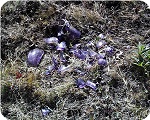
pretty much wiped out. Our only guide is the faint line cut on
the other side of the clearing. We find nothing else for 10 or so
poles until we come out to a natural open area. There is no doubt
about this polesite with all the broken purple glass scattered
about. My mom locates the second best find of the day, the bottom
hardware of a Cochrane set with the wire clamp still attached. So
where are the top ends? I metal detect the area and discover
three more wire clamps and the keeper pins that go with them. We
come to the top of the ridge and see Porphry Dike in the
distance. We head in the direction we think the line is but it's
not to be found, again! It's getting late so we call it a day and
head back. We'll just have to save that part for next year.
Day 2
We are up bright and early again and I'm not sure why. It's so
cold this morning it would freeze the balls off a brass monkey. I
survey the frost covered ground wishing the
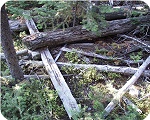
sun
would peak over the trees and warm things up a bit. After a hot
breakfast we head southeast this time. This section is
pretty well forested and the line is easy to follow.
There's not much other than the broken shards of purple glass and big
chunks of muncie and the rotted remains of poles and crossarms.
We come to a pole site with many shards of purple glass and a couple of
wire clamps. I metal detect the area for any other goodies but
nothing is to be found other than the many pieces of iron wire.
We continue on to the next pole but it is not to be found
anywhere.

In
fact the next few hours prove futile and the line is nowhere to be
found. The decision is made to come from the other end and work
back this direction to see if we can find where it went. About
half way back to camp we stop and rest at a pole site that looked
interesting enough to do some metal detecting. My mother looks
around and notices an insulator off the trail in the brush. It
turns out to be another Hemingray CD 295 in mint condition! Even
with 14 hours of daylight it goes pretty fast when you're having fun.
We pack camp and head down to where we left off on our last trip so
that we can try and find where we lost the line.
Day 3
We are up with the sun and the air is warmer here down lower on the
line as we ascend the mountain to the access point on the line where
we lost it last year. We break over the
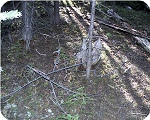
top
where the line comes into an open meadow. I start searching for
the line and I practically walk straight to it. I can't believe
how I couldn't find it last year. The first few poles don't
reveal much but the usual debris of rotted poles and the occasional
strand of guy wire and broken glass. What's interesting about
this line is they used the same wire for down guys as they did for the
primary and used trees as the guy anchors whenever available. The tree's
are pretty tall in the line cut making it more difficult to follow but you can see the rotting log piles stacked along the the side of the line when it was cleared
originally. We reach a

part of the line where it starts to descend steeply and there at the
next pole site is something I had been looking for on all my hunts on
the line. There half buried was a Cochrane cap.
Finally! After hunting all these miles of line one finally turns
up. This polesite must have been double armed as there were
multiple muncie pins to be salvaged. It also held a "whatsit?"
that looked like it could have been a crate for holding an
insulator. I later found out it was the inner core of a line
cable spool. Continuing down, the line crosses an old long
distance telephone lead. The poles on this lead were cut for 5
crossarms. The line was dismantled and the insulators and
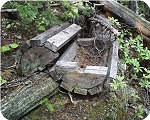
hardware
were buried in very shallow graves. Unfortunately the only insulators I dug up were
Hemingray and Pyrex 128s. The poles and arms were left to rot
back into the ground. If the line was accessible someone
would be able to salvage a large quantity of good arms. Down at
the bottom of the mountain we reach the last pole and there off to the
side of the line is a well preserved pole. It was nice to be able
to see what the original construction looked like. Searching the
area reveals a set of Cochrane end caps. Finally! A complete set
of caps. I sweep the metal detector around the area looking
for any more goodies until I tire of the incessant beeping from all the
bits of rusty line wire. Just by chance I happen to look up and
there hung up in the trees are two primary line conductors with two
Cochrane clamps attached to each. What luck! Getting them
down was another matter that required a little bit of work. Since
the majority of the line wire was salvaged I figure this bit here must
have been too much work for the linemen so they left
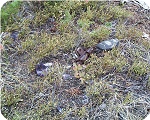
it behind. This brings me to my next unanswered question.
The two clamps on each line were too close together to have two sets of
Cochranes on each side of the pole so what did the bracket look like
that would have connected one set of Cochranes to two clamps?
Unfortunately I will probably never know. We cross the stream at
the bottom of the canyon and ascend the hill to the first pole site as
indicated by all the broken purple glass littering the area. Wish
there was some use for all that glass... The previous scavengers
were kind enough to leave me another wire clamp. We
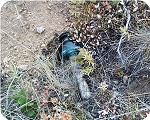
continue on and break out of the trees and onto a sagebrush covered
hillside. There is no line cut to guide us now and looking behind
us the trees have grown in such a way that there is no telltale sign
that you were even on a line. We ascend the hill in search of the
next polesite. My mom is off to my right a ways when all of a
sudden she yells "Hey, look at this!" I run over to where she is
and there in the grass is another CD 295 with the pin still in the
pinhole. How does she do that? We quickly locate the next
pole site a little ways further up the hill. I search the area on
the downhill side of the pole and there in the grass next to some
sagebrush is a set of Cochrane caps still

connected to the pin in really good condition as if it was dropped
there yesterday. I start metal detecting the area and locate
something buried. As the digger woman, it was my mother's job to
dig out whatever it was that was buried. She started digging the
spot with the little hand rake and found the ground to be incredibly
hard and full of roots. She hands me the rake and says she's
done. I give it a go for a few minutes and carve out a nice
little hole and find nothing for my efforts even though the metal
detector says there is something there. My mom starts chiding me
for giving up so easily but who wants to put so much effort in trying
to uncover another piece of line wire? She starts digging again
when
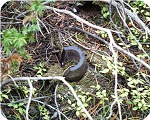
all
of a sudden she strikes metal and out pops the top cap of a
Cochrane! Further metal detecting reveals the bottom cap about
two feet away. Another set of caps! This is turning out to
be a fruitful day. The wood pin is pretty well rotted and I find
it strange that one set was in great condition and the other set got
buried. The next pole didn't give me any hardware but off in the
low brush was one single cochrane bell probably set there by a previous
hunter when whole bells were to be found. This one was in the
best condition I have found so far on this line with
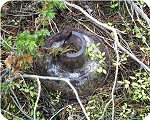
just a chip out of the neck. We discover we have lost the line
again and split up to cover more ground. I spend the next hour or
so wandering around trying to locate it. There are natural cuts
through the trees in this area and it's easy to think you've found the
line cut when you really haven't. I find it again but not where I
expected it. I back track a ways on the line and find another
goody.
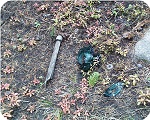
The broken pin with a bottom cap and clamp. After some searching
I locate my mom and we head on down the line until we come to a dried
up swamp. There on the other side is a dirt road we had been
walking down the day before when we had lost the line. I know I
can find the spot where we lost the line previously. I have my
mom stay at the last pole site and climb the hill looking for the last
pole we found the day before. I locate it and call back to my
mom. I can now see that the line took a turn at this pole to the
right. I should have realized that by all the guy wire here but
the natural cut that went straight ahead confused us the day
before. I head toward my mom's voice off in the distance and
locate the next lost polesite. There is broken purple glass all
over where a suspension set blew up. I search around the area for
anything good and see a chunk of a CD 295 sticking partially exposed in
all the rotted log debris. I pull it out expecting it to be
broken but I finally found my first whole 295! Of course I had
left my pack and camera with my mom so no picture to prove I finally
found one.
We head back picking up our goodies along the way. That stuff
sure gets heavy fast! On the way back we check out some of the
pole sites a little more thourghly and that's
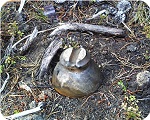
when I notice something I had not see anywhere on the line
previously. A pintype porcelain cable insulator. What's
that doing out here? This is supposed to be a glass line
untainted by foul fugly mud! Oh, you want to see a picture?
Very well... but this is only for historical purposes.
Well that wraps up another hunt on the Cochrane line. I could get into a lot more detail, especially about all the time spent trying to locate the line at times, but you're probably half comotose by now anyways so I'll spare you this time!











